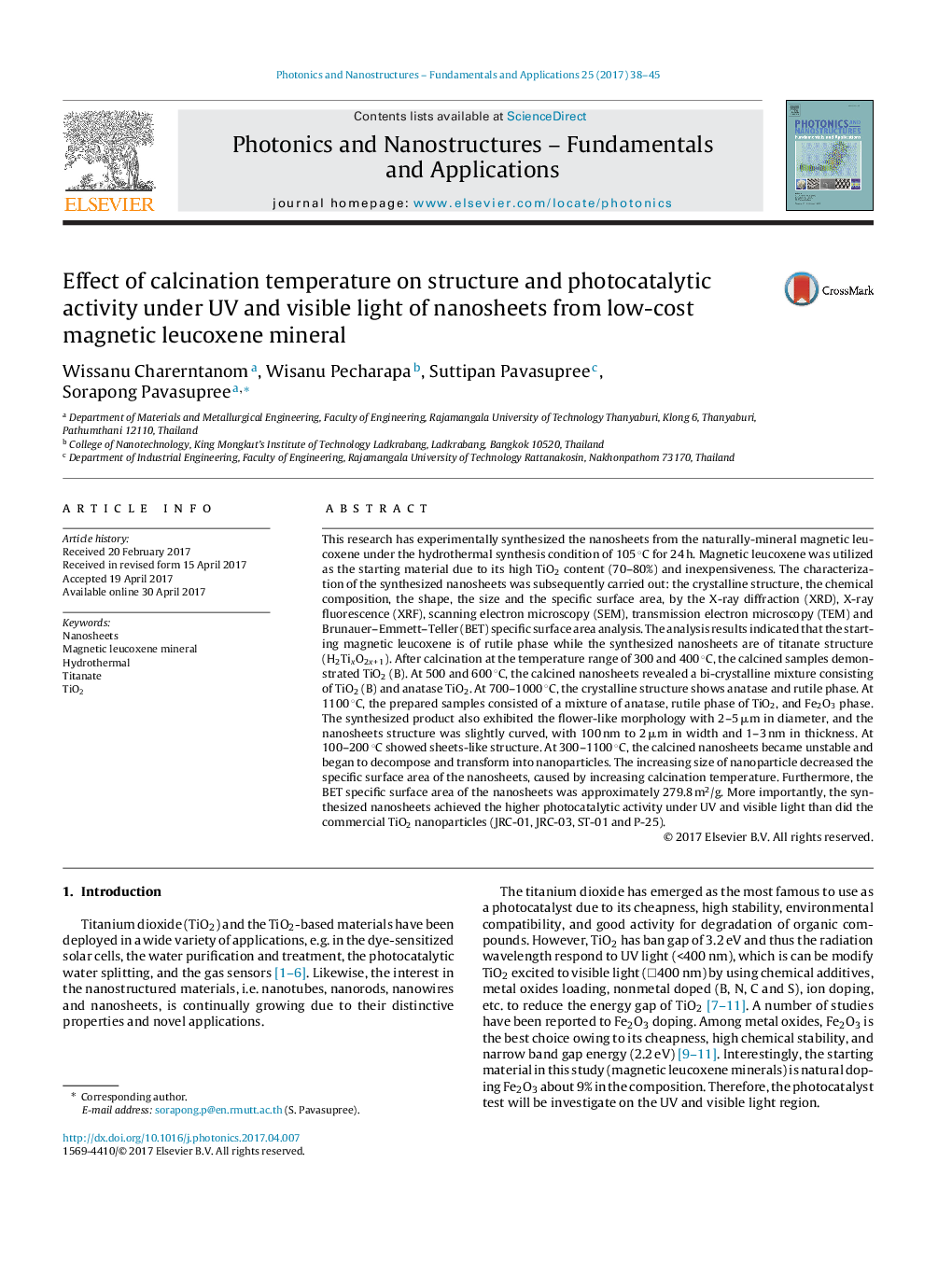| کد مقاله | کد نشریه | سال انتشار | مقاله انگلیسی | نسخه تمام متن |
|---|---|---|---|---|
| 5449921 | 1512823 | 2017 | 8 صفحه PDF | دانلود رایگان |
عنوان انگلیسی مقاله ISI
Effect of calcination temperature on structure and photocatalytic activity under UV and visible light of nanosheets from low-cost magnetic leucoxene mineral
دانلود مقاله + سفارش ترجمه
دانلود مقاله ISI انگلیسی
رایگان برای ایرانیان
کلمات کلیدی
موضوعات مرتبط
مهندسی و علوم پایه
مهندسی مواد
مواد الکترونیکی، نوری و مغناطیسی
پیش نمایش صفحه اول مقاله

چکیده انگلیسی
This research has experimentally synthesized the nanosheets from the naturally-mineral magnetic leucoxene under the hydrothermal synthesis condition of 105 °C for 24 h. Magnetic leucoxene was utilized as the starting material due to its high TiO2 content (70-80%) and inexpensiveness. The characterization of the synthesized nanosheets was subsequently carried out: the crystalline structure, the chemical composition, the shape, the size and the specific surface area, by the X-ray diffraction (XRD), X-ray fluorescence (XRF), scanning electron microscopy (SEM), transmission electron microscopy (TEM) and Brunauer-Emmett-Teller (BET) specific surface area analysis. The analysis results indicated that the starting magnetic leucoxene is of rutile phase while the synthesized nanosheets are of titanate structure (H2TixO2x + 1). After calcination at the temperature range of 300 and 400 °C, the calcined samples demonstrated TiO2 (B). At 500 and 600 °C, the calcined nanosheets revealed a bi-crystalline mixture consisting of TiO2 (B) and anatase TiO2. At 700-1000 °C, the crystalline structure shows anatase and rutile phase. At 1100 °C, the prepared samples consisted of a mixture of anatase, rutile phase of TiO2, and Fe2O3 phase. The synthesized product also exhibited the flower-like morphology with 2-5 μm in diameter, and the nanosheets structure was slightly curved, with 100 nm to 2 μm in width and 1-3 nm in thickness. At 100-200 °C showed sheets-like structure. At 300-1100 °C, the calcined nanosheets became unstable and began to decompose and transform into nanoparticles. The increasing size of nanoparticle decreased the specific surface area of the nanosheets, caused by increasing calcination temperature. Furthermore, the BET specific surface area of the nanosheets was approximately 279.8 m2/g. More importantly, the synthesized nanosheets achieved the higher photocatalytic activity under UV and visible light than did the commercial TiO2 nanoparticles (JRC-01, JRC-03, ST-01 and P-25).
ناشر
Database: Elsevier - ScienceDirect (ساینس دایرکت)
Journal: Photonics and Nanostructures - Fundamentals and Applications - Volume 25, July 2017, Pages 38-45
Journal: Photonics and Nanostructures - Fundamentals and Applications - Volume 25, July 2017, Pages 38-45
نویسندگان
Wissanu Charerntanom, Wisanu Pecharapa, Suttipan Pavasupree, Sorapong Pavasupree,